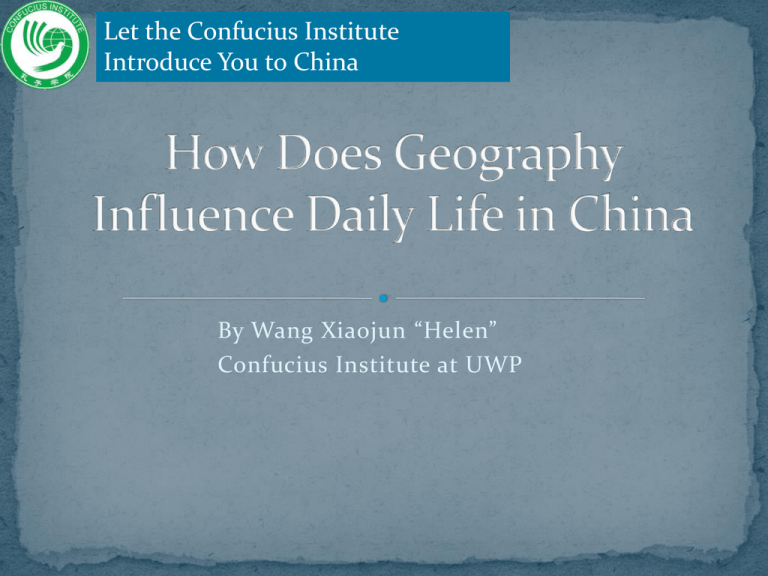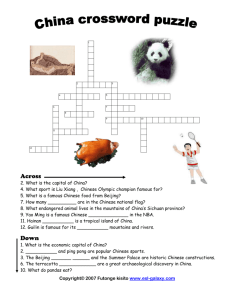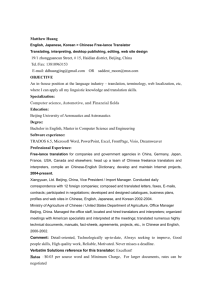Let the Confucius Institute Introduce You to China By Wang Xiaojun “Helen”
advertisement

Let the Confucius Institute Introduce You to China By Wang Xiaojun “Helen” Confucius Institute at UWP 西沙群岛 Paracel Islands Tajikistan Afghanistan 9.6 million square kilometer of land area = 96 000 hectare of land area 3 million square kilometer of sea area = 30 000 hectare of sea area 1.30628 billion population 5 500 km width from south to north 5 200 km length from east to west 5 time zones, same time - Beijing Time 23 provinces 5 autonomous regions 4 municipalities directly under the central government 2 special administrative regions Capital – Beijing (Peking) 22% of the world’s population Uneven distribution of population east – west plain areas - mountainous & plateau regions rural - urban Han people 90.56% 55 ethnic minorities 9.44% 壮Zhuang, 满Man, 回Hui,苗Miao,维 吾尔Uygur,彝Yi,土 家Tujia,蒙古 Menggu,藏Zang, 布依Buyi Three-step Staircase (from west to east): Qinghai-Tibet Plateau Inner Mogolia, Loess and Yunnan-Guizhou Plateaus, and Tarim, Junggar, Sichuan Basins Mountains Da Xing An Ling, Taihang, Wushan, etc. Mountainous areas: 2/3 Haiyuan (Ningxia) 8:05pm Dec-16-1920 Magnitude 8.5, 234 000 000 of death toll Tangshan 3:42am Jul-28-1978 Magnitude 7.8, 242 000 of death toll Five zones: Taiwan Province Tibet, Sichuan, Yunnan Gansu, Qinghai, Ningxia Hebei, Tianjing Guangdong, Fujian Wenchuan 2:28pm May-12-2008 Magnitude 8.0, 69 197 of death toll and 18341 of missing Temperature differences in January (-8°F ~ 75°F) Temperature differences in July ( 104°F ~ 46°F) Coal 3rd in the world ‘s reserve Northern/west areas 61% used for power Petroleum 8th in the world’s reserve 2nd in the world’s consumption 70 000 km of truck,3rd in the world Three east-west line: Beijing-Baotou-Lanzhou Lianyungang-Lanzhou- China Railway Map Urumqi Shanghai-HangzhouChangsha-LiuzhouGuiyang-Kunming Five south-north lines Beijing-Guangzhou Beijing-Shanghai Beijing-Kowloon Jiaozuo-Liuzhou Baoji-Chengdu-Kunming Qinghai-Tibet line 75% of Chinese people’s first choice Spring Festival Transportation 春运,chunyun 13.9% of total transportation of commodities Guangzhou Railway Station 1.93million km, 2nd in the world Every county has been connected by roads 6% of administrative villages without roads More than 1000 domestic lines More than 120 international lines Coastal port Shanghai, Dalian, Qinhuangdao, Tianjin, Qingdao, Ningbo, Xiamen, Guangzhou, Fangchenggang, etc. Changjiang / Yangtze River 长江 The Three Gorges Project The Grand Canal (Beijing -Hangzhou) Qinling Mountains and the Huaihe River 7% cultivated lands in the world Northern areas: Dry crops: Wheat, corn, Chinese sorghum, soybean Cotton, sweet potatos Apple, pear, peach, persimmons, walnuts, Chinese chestnuts, jujubes, grape Southern areas Rice Banana, pineapple, longan, lychee, coconut The general Facial Characteristics of northern Chinese people are tall nose more single-folds long and well-defined face hairs are more thick and straight lighter and taller The general Facial Characteristics of southern Chinese people are flattened out nose double eye-folds shorter face hairs are more softer darker and shorter Characteristics of Characteristics of northern people southern people Delicate and caring Introverted Bold and inhibited Extroverted Food customs in northern area Noodle Flavor of sour, salty Jasmine tea Liquor, 白酒baijiu Food customs in southern area Rice Flavor of spicy, sweet, plain Longjin tea, kongfu tea Liquor, 白酒 baijiu Music in northern area Music in southern area Loud and sonorous melodious Close to the emperor Center of political center Chinese Siheyuan & Hutong Noble and commentator Salty food Leisure Cold winter Personal loyalty Liqour ,白酒baijiu Salty food Activities related to the ice Abundant agricultural products Inconvenient transportation Hard-working Kind-hearted Spicy food Leisure and relax rhythm of life Tea Mahjong 麻将majiang Small car 1843-1945 semi-colony city International financial center Astute in business 里弄lilong/弄堂longtang Sweet and saucy food Open and anti-outsiders Center of China Less developed than coastal areas Frank and open personality A little bit more spicy and salty food leisure Out-oriented City Commerce & trade Active evening activiteis Morning Tea





